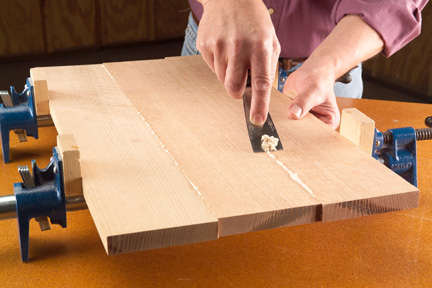
When gluing joints, what is the best way to clean up the squeeze-out: wipe with a wet cloth, scrape when dry or something else?
Andy Rae: It depends. Waiting to scrape the glue while it’s in a semi-soft state, or when the core of the glue line or puddle is rubbery and not wet, will give good results, as the glue peels from the wood without tearing fibers or leaving residue. It’s a timing game that typically takes about 30 minutes to an hour, depending on the glue and your shop’s climate. However, if you wait too long, parts of your project will likely come off along with the glue. I’m easily distracted in the shop so I prefer to wipe as I go. To avoid smearing the glue around, which leaves a residue that will show up under the finish, I use a damp cloth that I continually re-fold to expose a clean face for each wipe. Resist the temptation to wash the area with a wet rag, as it will soak the wood, weakening the joinery and unduly raising the fibers which will need subsequent sanding. One tip for complex glue-ups: As soon as the clamps are on, go over all the areas of squeeze-out with a quick swipe to dampen the glue, which keeps it from skimming over. This approach buys you more time to deal with each area more thoroughly.
Kevin Hancock: I am a fan of wiping it off with a wet cloth.
Richard Jones: I use all of those methods. Also consider pre-finishing. Glue comes off a finished surface quite easily.






